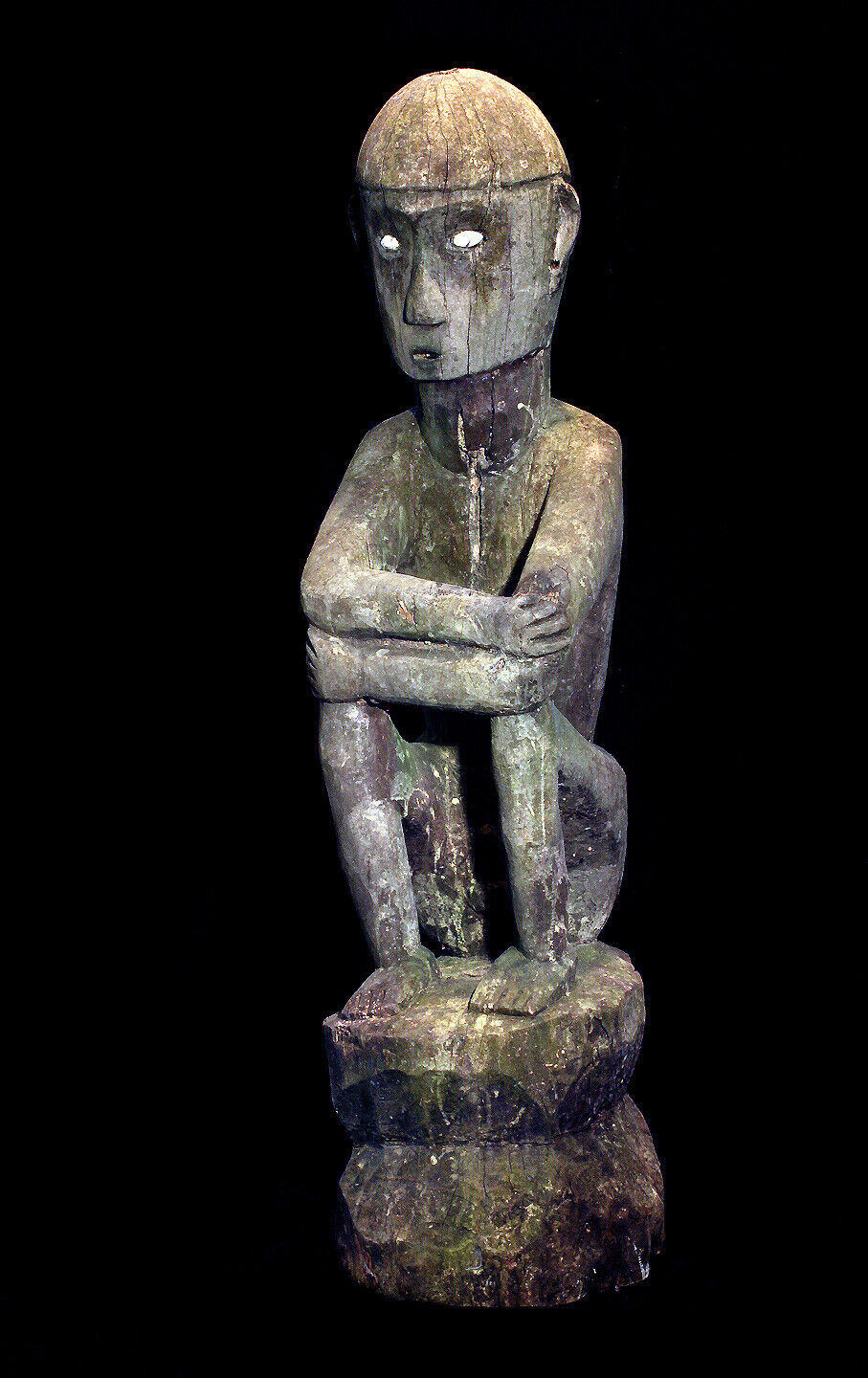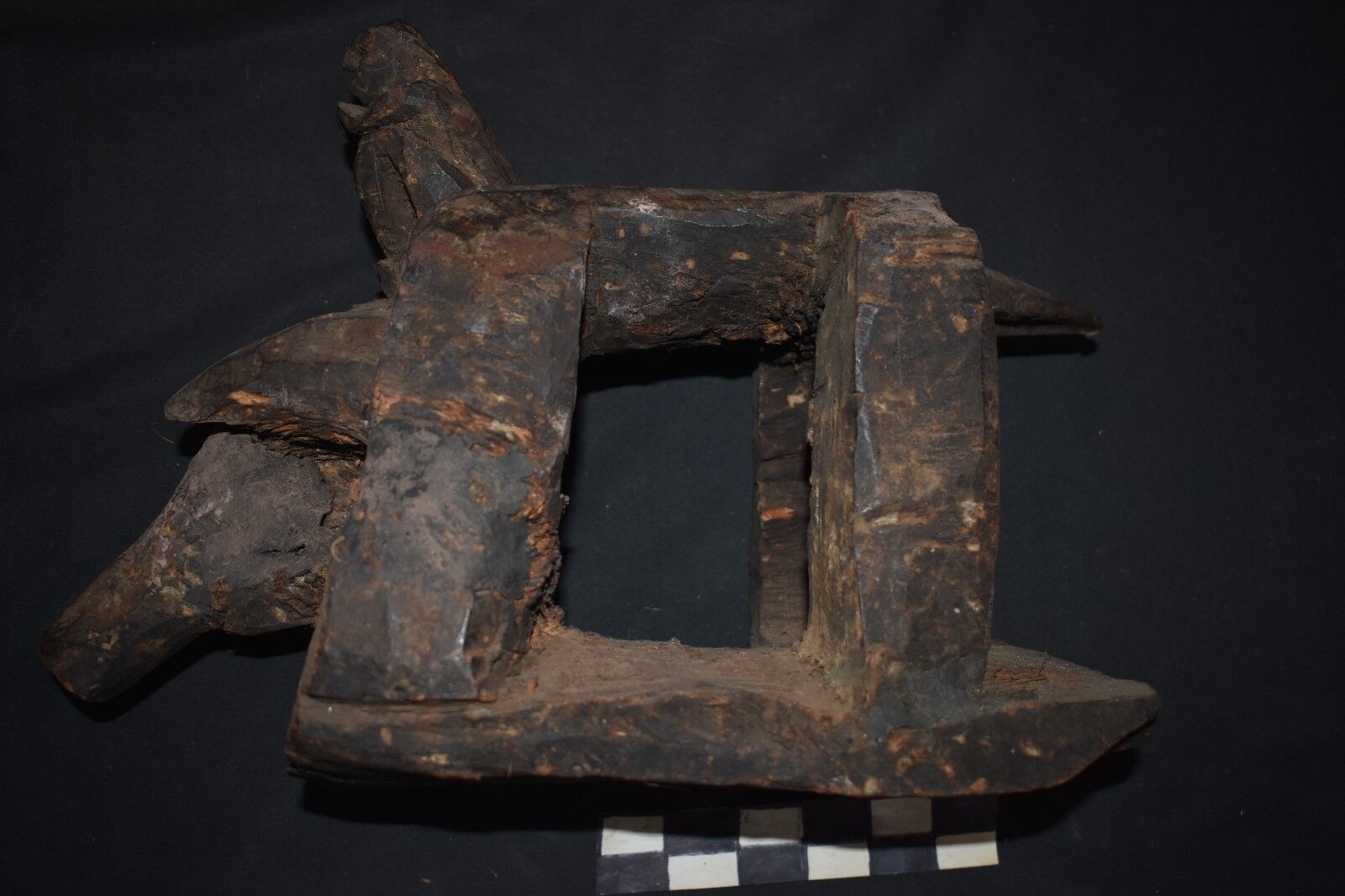-40%
IFUGAO TRIBAL USED SEATED “KING” BULUL!
$ 2217.6
- Description
- Size Guide
Description
IFUGAO HAND CARVED, HARD “NARRA” MAHOGANY WOOD, TRIBAL USED, SEATED, OVERSIZED “KING” BULUL STATUE!IT’S HUGE; MEASURING 32 INCHES TALL X 8 INCHES WIDE X 7 INCHES DEEP;
THAT FEATURES ORIGINAL INLAID HAND CARVED WHITE SHELL EYES! FROM THE HEAD HUNTING TRIBE: "IFUGAO" IN THE CORDILLERA MOUNTAINS ON THE ISLAND "LUZON" IN THE PHILIPPINES. RARE AND UNUSUAL; WITH A FINE, RICH, DARK, BROWN PATINA. THIS IS AN EXTRAORDINARY PIECE OF IFUGAO TRIBAL USED ASIAN ART! EXCELLENT ORIGINAL CONDITION.
SIMILAR EXAMPLES CAN BE FOUND ON PAGE #49 IN THE BOOK ENTITLED: “
THE LAST FILIPINO HEAD HUNTERS.”
(PLEASE SEE THE EBAY POSTED PICTURES OF THAT MENTIONED PAGE # AND THE BOOK’S COVER FOR YOUR REFERENCE)
THIS IS THE VERY BEST OVERSIZED “KING” BULUL STATUE THAT I HAVE EVER POSTED ON EBAY. IT SHOWS WEAR AND SIGNS OF TRIBAL USE: DRIED WHITE + GREEN TROPICAL JUNGLE MOLD AND MANY LAYERS OF PATINATED SACRIFICIAL CEREMONIAL ELEMENTS THAT INDICATE USE IN FREQUENT ANNUAL IFUGAO SHAMAN'S SACRED HARVEST RITUALS!
I’M 70 YEARS OLD AND HAVE BEEN COLLECTING TRIBAL ART FOR MORE THAN 36 YEARS. ALL THE ITEMS I SELL ON EBAY I ACQUIRED FROM INTERNATIONAL TRAVEL, BOUGHT AT AUCTION, OR INHERITED FROM MY GRANDFATHER! MY GRANDFATHER WORKED IN SOUTHEAST ASIA, SOUTH AMERICA, AND AMERICA'S SOUTH WEST IN THE 30'S. HE TRAVELED TO BURMA, INDONESIA, THE PHILIPPINES, AND MEXICO WITH A NATIONAL GEOGRAPHIC MAGAZINE PHOTOGRAPHER.
THANKS FOR LOOKING. I HOPE YOU ARE THE LUCKEY WINNER... GOOD LUCK!
PLEASE SEE THE OTHER ITEMS THAT I HAVE UP FOR AUCTION.
THANK YOU. ALL THE BEST: DAVE
WORLD WIDE SHIPPING: INTERNATIONAL BUYERS PAY FOR THE ACTUAL SHIPPING COST FOR THE SERVICE THEY SELECT...
A Bulul is a carved wooden figure used to guard the rice crop by the Igorot peoples of northern Luzon. The sculptures are highly stylized representations of ancestors, and are thought to gain power from the presence of the ancestral spirit. The Ifugao are particularly noted for their skill in carving bululs. Bululs are used in ceremonies associated with rice production and with healing. Creation of a bulul involves ritualS by an Ifugao priest to ensure that the statue gains power. The bulul is treated with care and respect to avoid the risk of the spirits of the ancestors bringing sickness. The figures are placed in rice granaries to bring a plentiful harvest. A large granary may need two bululs, and a wealthy noble may also have one or more bululs in his house. Male and female Bulul statues are often found together, with sex-related symbols such as the mortar for the female and pestle for the male. A male bulul may sometimes be decorated with a g-string, and a female with a waist cloth, earrings and anklets. Although the form varies, the bulul is commonly represented as seated on the ground, with arms crossed over his upraised knees. The bulul has a simplified form, and is traditionally carved from narra or ipil wood or sometimes stone. The bulul is touched by hands dipped in blood of a chicken or pig in ritual called tunod during the rice planting season. Over time the blood imparts a dark color to the figures, overlaid with a patina of grease from food offerings. Bululs are handed down to the first child of a family. Typically the older statues have beetle holes made by insects in the granary.
Ifugao culture revolves around rice, which is considered a prestige crop. There is an elaborate and complex array of rice culture feasts inextricably linked with taboos and intricate agricultural rites, from rice cultivation to rice consumption. Harvest season calls for grandiose thanksgiving feasts, while the concluding harvest rites "tungo" or "tungul" (the day of rest) entail a strict taboo of any agricultural work. Partaking of the rice wine (bayah), rice cakes, and 'moma' (mixture of several herbs, powdered snail shell and betel nut/ arecoline: and acts as a chewing gum to the Ifugaos) is an indelible practice during the festivities and ritual activitiess. their retual and Agricultural terracing is their principal means of livelihood along with farming. Their social status is measured by the number of rice field granaries, family heirlooms, gold earrings, carabaos (water buffaloes), as well as, prestige conferred through time and tradition. The more affluent, known as kadangyan were usually generous by nature, giving rice to poor neighbors in time of food shortage(s) and/or hardship(s). Furthermore, their culture was known for their legal system, using one of the world's most extensive oral legal traditions specifying the offense depending on the use of custom law; trial by elders (influenced in part by public opinion); or trial by ordeal. The wealthy were subjected to greater fines than the poor.
Untouched by the influences of Spanish colonialism, Ifugao culture value kinship, family ties, religious and cultural beliefs. They're unique among all ethnic groups in the mountain province, not only for their interesting customs and traditions but also for their narrative literature such as the hudhud, an epic dealing with hero ancestors sung in a poetic manner. Another feature unique to the Ifugao is their woodcarving art, most notably the carved granary guardians bului and the prestige bench of the upper class, the hagabi. Their textiles renowned for their sheer beauty, colorful blankets and clothing woven on looms. Houses were well-built, characterized by as a square with wooden floors, windowless walls, and pyramidal thatch roofs. Elevated from the ground by four sturdy tree trunks, they feature removable staircases that were hoisted up at night to prevent entry by enemies and/or wild animals. Lastly, their attire remain traditional for male Ifugaos, donning the wanno or g-string; there are six types of wanno which are used depending on the occasion or the man's social status. Ifugao women, on the contrary, wear tapis, a wraparound skirt; there are five kinds of skirts worn, depending on the occasion and/or status of the woman/girl.



















